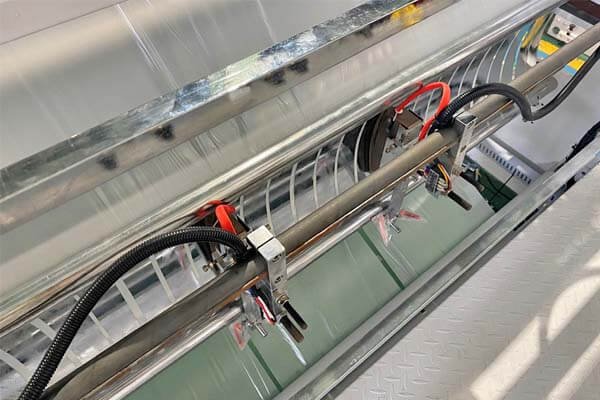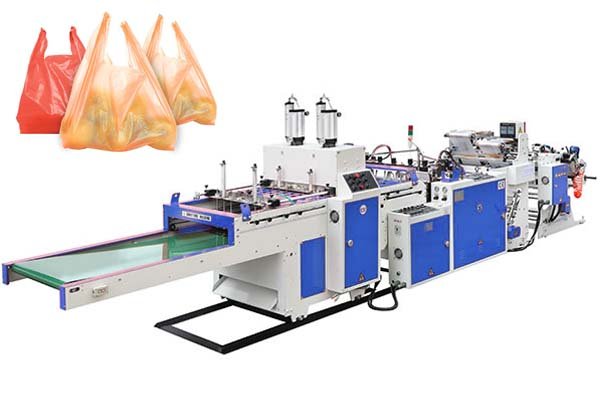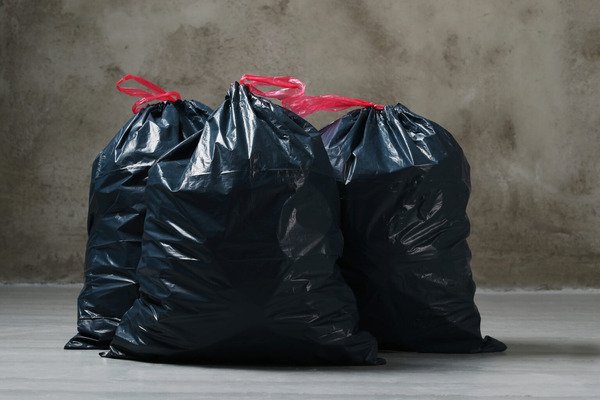
Are you struggling to estimate your production yield for garbage bags? This uncertainty can lead to material waste and inaccurate cost calculations. We can give you the clarity you need to optimize production.
The number of garbage bags from 1 kg of plastic depends on the bag's size, thickness, and material density. For a standard medium-sized kitchen bag (e.g., 24x32 inches) with a 30-micron thickness, you can typically produce between 70 to 80 bags.
This calculation is fundamental for any manufacturer. It helps you manage raw material inventory and set accurate pricing. The final count is a balance of three key factors. First is the film thickness, measured in microns. Second are the bag's dimensions, its length and width. Third is the specific density of the plastic resin you use, like Low-Density Polyethylene (LDPE) or High-Density Polyethylene (HDPE). Our BagMec® machines are engineered to give you precise control over these variables. This precision ensures you achieve a consistent bag count every single time.
Let's look at an example. A lighter-duty bag with a 15-micron thickness could yield nearly double the quantity, around 140 to 160 bags from the same kilogram of material. On the other hand, a heavy-duty industrial bag with a 50-micron thickness might only produce 40 to 50 bags. This is why our "Smart Tension Control" technology is so valuable. It maintains a uniform film thickness throughout the production run. This feature directly prevents material waste. It also guarantees your bag count per kilogram is predictable and reliable, which is essential for profitability.
What is the cost of making plastic bags?
Understanding the true cost of making plastic bags is crucial for your business's success. The final price goes far beyond just the raw material. Let's break down the numbers together.
The manufacturing cost per plastic bag typically ranges from $0.01 to $0.15. This cost is heavily influenced by fluctuating raw material prices, machine efficiency and speed, energy usage, labor costs, and any custom features like printing or specialized handles.
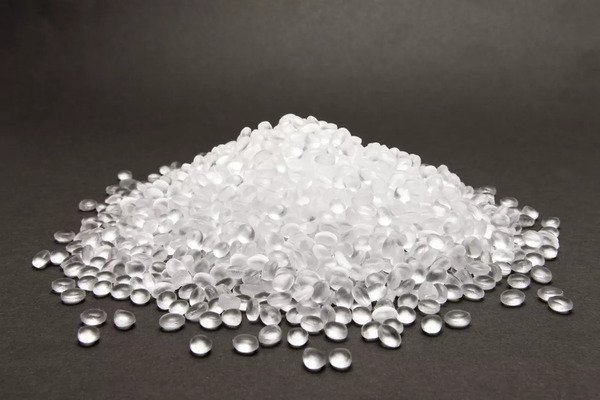
To truly grasp the cost per bag, you need to analyze each component of the production process. The final number on a spreadsheet comes from a combination of variable and fixed costs. We help our clients understand this breakdown so they can see how investing in the right machinery, like our energy-efficient models, directly improves their bottom line.
Breaking Down the Core Cost Components
The cost of a single plastic bag is a sum of several parts. Some costs change daily, like raw materials, while others, like your machine investment, are more stable. Managing each of these is key to competitive pricing and healthy profit margins.
Here is a typical breakdown of where the money goes:
| Cost Component | Estimated % of Total Cost | Key Factors Influencing Cost | How BagMec® Helps |
|---|---|---|---|
| Raw Materials | 50% - 70% | Market price of resins (LDPE, HDPE), use of recycled materials, film thickness. | Our machines are optimized to run recycled and biodegradable materials like PLA, offering you cost flexibility. |
| Machinery | 10% - 20% | Initial investment cost (amortized over time), maintenance needs, and spare parts. | We offer a wide price range ($8,500–$88,000) and build durable machines proven by a 72-hour stress test. |
| Energy | 5% - 15% | Electricity needed to power the extruder, sealing bar, and motors. | Our machines feature energy-saving servo motors that can reduce power consumption by up to 30%. |
| Labor | 5% - 10% | Operator salaries, training, and the number of workers needed per machine. | Our fully automated systems with PLC control and intuitive touchscreens reduce the need for manual labor. |
| Overhead & Other | 5% - 10% | Factory rent, printing inks, packaging for finished goods, and waste management. | Our "Smart Tension Control" technology can reduce material waste by 18%, directly cutting overhead costs. |
How Machine Choice Directly Impacts Your Cost Per Bag
The machine you invest in is one of the biggest factors in your cost per unit. It's not just about the purchase price. It's about speed, efficiency, and reliability. An inefficient machine will cost you more in the long run through waste and downtime.
Let's consider two different scenarios. If you are starting out in retail bag production, our T-Shirt Bag Making Machine (priced between $17,000 and $32,000) is a great entry point. It's designed for high-volume, standard-sized bags. However, if your clients need a more premium product, our Loop Handle Bag Making Machine ($33,000-$38,000) adds that value.
The real difference in cost comes from performance. A higher-speed machine producing 1,200 bags per hour will have a much lower cost per bag than a machine that only produces 300. Our fully automated systems also reduce labor costs and minimize human error, leading to less material waste and higher-quality output. This is how our German packaging client achieved 99% uptime and reduced their waste by 18% after deploying our FFS bag machines.
Raw Material Selection: A Critical Cost Driver
The plastic resin is the single largest cost component, often making up more than half of the total production cost. The type of material you choose will directly affect your expenses and the market you can serve.
Let's compare the most common options:
| Material Type | Average Cost per kg (Example) | Pros | Cons | BagMec® Machine Compatibility |
|---|---|---|---|---|
| Virgin LDPE/HDPE | $1.20 - $1.80 | Provides high clarity, strength, and consistent quality. | Prices fluctuate with the oil market; less eco-friendly. | All our machines are perfectly calibrated for virgin materials. |
| Recycled Pellets | $0.80 - $1.20 | Lower material cost and a better environmental profile. | Quality can vary; may require minor process adjustments. | Our machines are engineered to handle recycled materials with high efficiency. |
| Biodegradable PLA | $3.00 - $5.00 | 100% compostable; meets demand for sustainable products. | Higher upfront material cost; requires specific temperatures. | We co-developed specialized machines for a US eco-brand to run PLA film. |
Your choice depends on your target market. If you are supplying eco-conscious retail chains, the higher cost of PLA may be justified by the premium price the final product can command. If you are producing basic garbage bags, focusing on recycled pellets can give you a significant cost advantage. We design our machines to be versatile, so you can adapt to market demands and material availability.
How do I choose the right garbage bag making machine?
Selecting the right machine is the most critical decision for your business. This choice will define your production capacity, final costs, and the types of products you can offer your customers.
To choose the right machine, you must first define your target product (e.g., t-shirt, flat, heavy-duty). Then, assess your required output speed, desired level of automation, and material compatibility. Finally, always verify the manufacturer's durability and after-sales support.
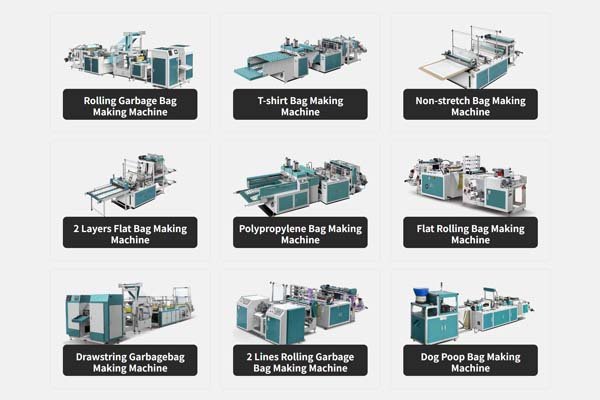
This process might seem complex, but breaking it down into logical steps makes it manageable. We guide our customers through these steps every day. From startups to established industrial players, the core principles of choosing the right equipment remain the same. It is an investment in your company's future.
Step 1: Define Your Product
Before you look at any machine, you must know exactly what kind of bag you want to produce. Different bags require different technologies for cutting, sealing, and handling.
We build specialized machines for every need:
- For Retail & Shopping: Our T-Shirt Bag Making Machine ($17,000-$32,000) is perfect for creating the shopping bags you see everywhere. It uses a bottom-sealing process and a hydraulic punch for the handles.
- For Home & Municipal Use: The Garbage Bag Machine ($23,000-$35,000) is designed for producing bags on a roll with perforations for easy tearing. It can handle both flat and star-sealed bottoms.
- For Industrial & Logistics: Our Heavy Duty Bag Machine ($12,000-$23,000) is built to work with thicker films to create durable bags for construction debris, commercial waste, or courier services.
The type of seal (side seal, bottom seal) and any special features (like the handles on a patch handle bag) will determine which machine model is right for you.
Step 2: Assess Your Production Volume Needs
How many bags do you need to make per day or per month? Your answer will determine the required speed and automation level of your machine.
Think about your business scale. A startup, like our client Priya Kapoor from India, may begin with a compact, semi-automatic machine that fits a smaller budget. It allows her to enter the market without a massive upfront investment. In contrast, a large-scale operation, like our German packaging partner, needs fully automated, high-speed lines to meet huge demand. Their eight FFS bag machines run continuously to supply major snack brands.
At BagMec®, we cater to both ends of the spectrum. Our machines offer a wide range of output speeds, from standard models to high-speed systems that can produce over 1,200 bags per hour. And because we offer flexible MOQs starting from just one machine, you can scale your production as your business grows.
Step 3: Consider Automation and Custom Features
Automation is a key factor in long-term profitability. While a semi-automatic machine has a lower initial price, a fully automated machine offers significant savings over time.
- Semi-Automatic: Requires an operator to manage parts of the process, like stacking or packing the finished bags. It is a good starting point for smaller operations.
- Fully Automated: Our fully automated systems use a PLC controller and touchscreen interface to manage the entire process from film feeding to cutting, sealing, and stacking. This reduces labor costs, minimizes the chance of human error, and ensures consistent quality.
Beyond automation, think about custom features that can give you a competitive edge. We can integrate units for logo embossing, precision die-cutting for unique shapes, or QR code printing, as we did for an Indian logistics giant. These customizations allow you to offer unique products that command a higher price.
Step 4: Evaluate Manufacturer Reliability and Support
A machine is only as good as the company that stands behind it. When you invest tens of thousands of dollars, you need to be sure you are getting a reliable product and dependable support.
This is where we focus our efforts.
- Quality Control: Every BagMec® machine passes a strict 5-stage inspection protocol, including material hardness testing, laser alignment, and a 72-hour continuous operation stress test.
- Certifications: Our machines are CE compliant and built in our ISO 9001 certified facility, ensuring they meet global quality and safety standards.
- Durability: We use high-carbon steel components and corrosion-resistant coatings so our machines perform reliably for years, even in humid environments.
- Global Support: We provide comprehensive logistics support, including EXW, FOB, CIF, and DDP trade terms. We also offer optional on-site installation and training. Our "Future-Ready" technology even allows for remote diagnostics to solve issues quickly. For clients like Priya, whose previous vendor offered poor support, this is a game-changer.
Conclusion
Calculating your bag count per kilogram and understanding your costs are vital for success. It comes down to the details of your material and the efficiency of your equipment. Choosing the right machine by defining your product, volume, and support needs ensures a profitable future.




